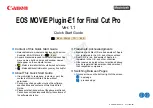
Working With Systems and System Files
37
NetLinx Studio (v2.4 or higher)
Working With Systems and System Files
Working With Systems
A System in NetLinx Studio represents an Axcess or NetLinx-based control system. Each System
has its own Master Controller (and associated Master Source Code file) and set of devices on the
bus (and their associated files). Systems are represented by System Folders in the Workspace tab of
the Workspace Window. Any Project can contain multiple Systems, and Systems only exist within
the context of a Project.
A control system typically uses several different types of files. You must have a Master Source
Code file to download to the Axcess or NetLinx Master Controller, but a complete control system
also typically uses an assortment of other file types. The System file types recognized by NetLinx
Studio are described below:
In NetLinx Studio v2.0 (or later), all Projects and associated Systems and System files are linked to
the Workspace, so that you can add and remove Projects and Systems without having to make
copies of the files. NetLinx Studio v2 also allows you to copy and paste Projects within the
Workspace; in case you need to create several similar Projects you can quickly generate multiple
Projects and modify each one as necessary.
Even if you don't have multiple links to the same file, and instead have only a single link, you still
need to be careful about altering the file. If you are linking to a file that other people might use, they
will be affected by the changes you make to the file. So, if you intend to make changes to a System
file, and you want those changes to be specific to only one System in the Workspace, you should
Source Code Files
These include the Master Source Code File and all other source code
(.AXS) files associated with the System.
Include files
These are Axcess or NetLinx code files (.AXI) that are referenced in
any source code file by the 'Include' statement.
Module Files
NetLinx Module files provide pre-fabricated (.AXS) code or compiled
(.TKO) code to control a specific device on the bus. Module files can-
not be designated as master files. When the System is being com-
piled, Module files are compiled first, then copied to the directory
where the designated Master Source code file resides.
User Interface (UI) files
These files (.TPD, .TP4 or .KPD) are created in TPDesign3,
TPDesign4 or KPDesign, and contain touch panel pages, buttons and
their associated functionality.
Infrared (IR) library files
These files (.IRL or .IRV) are created in the IREdit Program, and con-
tain infrared (IR) control functions for IR controlled devices.
IR Database files
These files (.IRN) contain links to either the AMX IR Database or to a
user-defined IR database.
Other files
In many cases, it is helpful to save document and image files (for
example, .TXT, .DOC, .BMP) with the other system files, even if they
are not directly utilized by the control system.
Since all System files are linked to the Workspace, when you open a file for editing,
you are opening and editing the actual file, not a local copy. It is important to
understand that in the event that the file is linked to multiple Systems, any changes
made to the file will be reflected in every instance that the file is used (not just the
System that you were in when the changes were made).
Содержание NETLINX STUDIO V2.4
Страница 1: ...instruction manual Software NetLinx Studio v2 4 or higher ...
Страница 16: ...NetLinx Studio v2 4 or higher 4 NetLinx Studio v2 4 or higher ...
Страница 32: ...The NetLinx Studio v2 4 Work Area 20 NetLinx Studio v2 4 or higher ...
Страница 44: ...Working With Workspace Files 32 NetLinx Studio v2 4 or higher ...
Страница 88: ...Working With Systems and System Files 76 NetLinx Studio v2 4 or higher ...
Страница 118: ...Programming 106 NetLinx Studio v2 4 or higher ...
Страница 152: ...Working With Online Devices 140 NetLinx Studio v2 4 or higher ...
Страница 199: ...Index 187 NetLinx Studio v2 4 or higher ...
















































